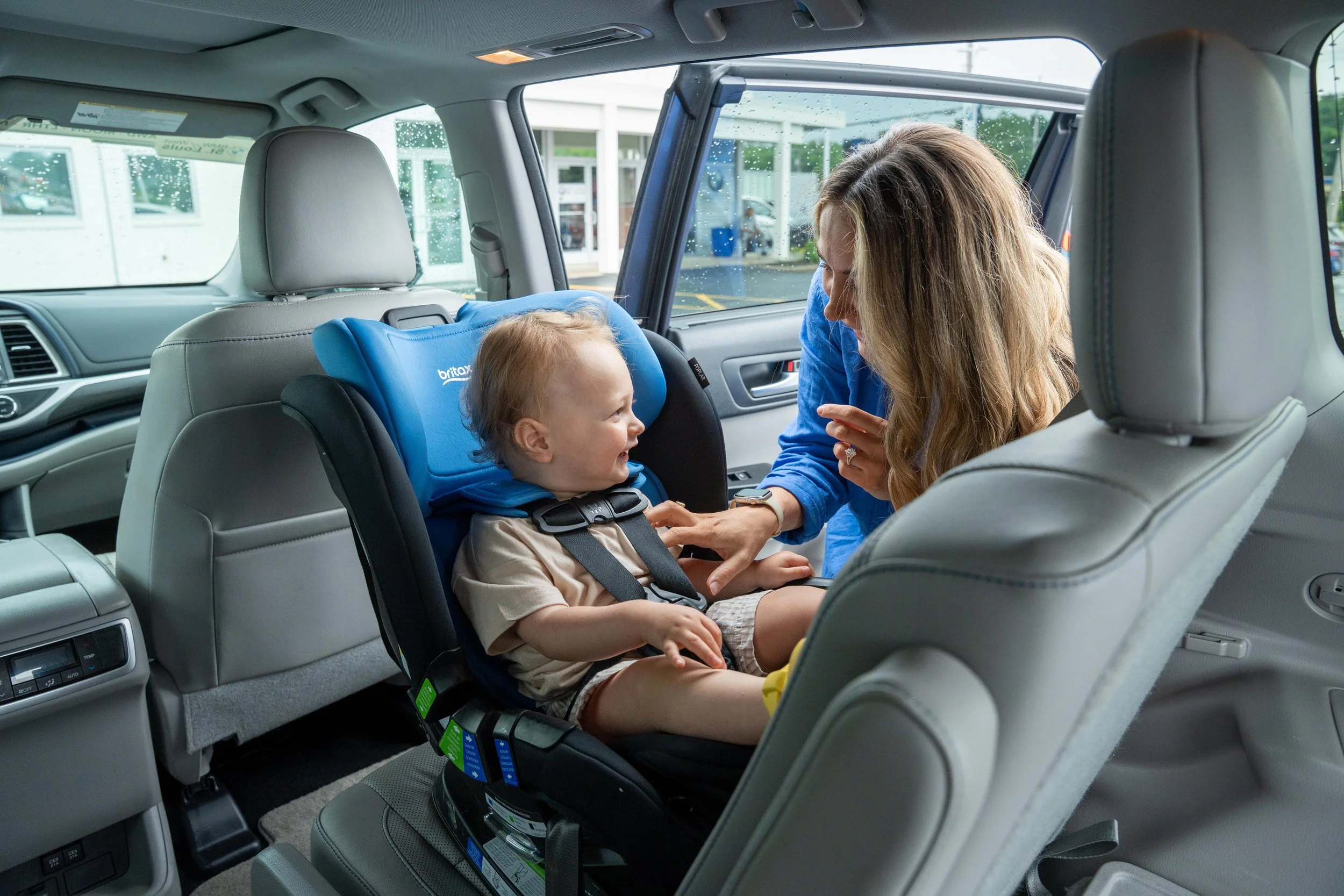All-Wheel Drive vs. Four-Wheel Drive: Which Is Best For Your Family Car?
Trying to figure out which drive option is best for your family car’s needs? It all comes down to where you drive on an everyday basis.
When you're choosing a family car, understanding the vehicle's drive system is crucial. It impacts everything from how your car handles different road conditions to its overall performance. But what exactly does "drive" mean, and how does it affect your decision when buying a family car?
If you’re new here- I’m Kelly the Car Mom and helping families find the best car for their needs is my thing. I’m a Child Passenger Safety Technician (CPST), mom of four, and if there is one thing I know better than anything else - it’s family cars. I want to help you narrow down everything you need to consider when making your car perfect for everyday life.
So without any further introduction, let’s break down everything you need to know when it comes to choosing between AWD vs 4WD.
What Is Drive?
Before we go into AWD vs. FWD, let’s take a step back and break down what drive actually means.
In simple terms, "drive" refers to how power from the engine gets to the wheels. This system plays a big role in determining a car's traction (how well it grips the road) its handling, and its overall performance.
Picking the right drive for your family car ensures you choose a car that meets your specific driving needs, whether you’re tackling snowy roads or just running errands around town.
What Is All-Wheel Drive?
All-Wheel Drive (AWD) is a type of drive system that automatically distributes power to all four wheels as needed. Unlike other systems where you might have to manually engage extra traction, AWD does the work for you.
This feature is particularly beneficial because it strikes a balance between fuel economy and extra traction. It’s designed mainly for paved roads, but it can handle some light off-roading, which is ideal for the occasional camping trip or a drive on a dirt road.
You’ll find AWD in a wide range of vehicles, from cars and crossovers to SUVs. In fact, if you’re shopping for a family car, chances are high that the models you're considering come with AWD as a standard or optional feature. This makes it a popular choice for many families who primarily drive on paved roads, but want the security of extra traction when conditions are a bit more intense.
How Does AWD Work?
AWD systems connect the engine to both the front and rear wheels, allowing power to be distributed to all four wheels. Most AWD cars can even adjust how much power goes to the front versus the rear wheels, depending on the situation.
The most common type of AWD is "part-time AWD." In this system, the car primarily uses front-wheel drive, but can automatically switch to all-wheel drive when it detects that the front wheels are slipping. This detection happens through sensors that monitor the wheels for slippage, ensuring that power is sent where it’s needed most.
While part-time AWD is efficient and works well in many scenarios, it does have its limits in extreme conditions. For instance, if you’re dealing with deep snow or mud, it might not perform as well as a system specifically designed for off-road use.
Kelly, Why Should I Consider AWD?
One of the main reasons to consider AWD is its adaptability. It automatically adjusts to changing road conditions without you needing to do anything. If you encounter a sudden rainstorm or a patch of ice, AWD kicks in to provide the extra grip needed and still maintainins good fuel efficiency.
This makes AWD especially suitable for regular driving on paved roads, which is what most family cars are built for. It’s common in a variety of vehicles, so whether you’re looking at sedans, crossovers, or SUVs, you’ll likely find AWD available. For families who value convenience and safety without sacrificing fuel economy, AWD is a strong contender.
What Is Four-Wheel Drive?
Four-Wheel Drive (4WD) is another type of drive system, but it's designed for more rugged use. Unlike AWD, 4WD splits power evenly between the front and rear wheels, which gives it the best traction in off-road conditions. However, this system isn’t as practical on paved roads and is usually found in larger cars like trucks and SUVs.
4WD cars are built to tackle tougher terrains and are ideal for off-road adventures. When you need a cars that can handle rocky trails, deep snow, or muddy paths, 4WD is the best choice. However, on regular pavement, 4WD is less efficient and can cause unnecessary wear on your tires if used improperly.
How Does 4WD Work?
4WD systems use a transfer case gearbox to split power evenly between the front and rear wheels. This ensures that both axles turn at the same speed, providing better traction in off-road or slippery conditions. Typically, 4WD systems include a switch or lever that allows you to adjust between 4WD and 2WD modes, giving you control over when to engage the system.
4WD is best suited for low-speed driving in tough conditions, such as climbing steep hills or navigating rocky paths. It is not designed for dry pavement on side streets or the highway. That being said, ome modern 4WD cars come with an automatic mode that activates 4WD at lower speeds, offering a bit more flexibility in mixed driving conditions. Still, I’d be weary when you’re considering actually how much you would use 4WD.
Kelly, Why Should I Consider 4WD?
4WD is essential if you plan on doing any serious off-roading or if you need a car with higher towing capabilities. It’s commonly found in larger, more rugged cars like SUVs and trucks, which are designed to handle extreme conditions.
If your family enjoys outdoor activities that require driving on unpaved roads, or if you live in an area where winter storms are frequent, 4WD is the better choice to consider. It’s also a good option if you need to tow heavy trailers, as the added traction helps manage the load more effectively.
AWD vs. 4WD: What’s the Difference?
Both AWD and 4WD systems send power to all four wheels, improving traction. However, they differ in how they operate and what they’re best suited for.
AWD is designed for everyday driving. It’s ideal for on-road driving and light off-road use. On the other hand, 4WD is designed for low speeds and challenging terrains.
As manufacturers have realized more and more families like the option for both, newer cars blur the lines between AWD and 4WD by offering advanced systems that mimic the capabilities of both. While there aren’t a ton of these options yet, I’m excited to see this option become more available in the next few years.
Best Family Cars with AWD
If you’re looking for AWD, almost every single SUV on the market has this option available standard or as an add-in option. This makes it hard to give a specific list of the best family cars with AWD, so instead I’m recommending you check out my post: Best Cars For Families: Everything You Need To Know About Choosing Your Family Car. This will help you hone in on the right car for the other needs your family has, since I can almost guarantee there is an AWD option available depending on the trim level you choose.
If you’re interested in a minivan with AWD, there are two options available: Chrysler Pacifica and Toyota Sienna. All trim options are available with AWD as an option in the Sienna, but only the two highest trim levels in the Pacifica (the Limited and Pinnacle) have AWD.
Now, if you cannot decide between an SUV and minivan as the better option for your family car (AWD aside since both models have it with certain manufacturers), my post - SUV vs. Minivans - The Great Debate! - is a great guide. This will help you see the pros and cons of both options, so you can better see which would keep up with your daily routine.
Best Family Cars with 4WD
Unlike AWD, 4WD is a lot less popular as a drive option, so you will have to shop around for more specific models. If you’re leaning towards a 4WD car for your family, here are some top options I’ve tested for families and really like:
Trucks! I know this is not the typical family car choice, but if you want 4WD and an excellent second row, give a truck a test drive
AWD or 4WD: Which Is Best for Your Family Car?
When it comes to choosing between AWD and 4WD for your family car, it really depends on your driving habits and needs. If you primarily drive on paved roads with the occasional light off-roading, an AWD car is likely the better option. It provides the traction you need without compromising on fuel efficiency or comfort.
On the other hand, if you frequently drive on tougher terrains or need a car with strong towing capabilities, 4WD might be the right choice. Keep in mind, though, that 4WD is usually found in larger, more rugged cars, which might not be necessary for the average family.
Most family cars, especially SUVs and crossovers, come equipped with AWD rather than 4WD. This is because AWD is more practical for the type of driving most families do. If you’re looking at popular family cars, you’ll likely find that a ton of them all of them offer AWD as a standard or optional feature.
However, if you’re considering a minivan, you should know that not all minivans offer AWD. A few models do, but they are exceptions rather than the rule. This is something to keep in mind if you’re leaning towards a minivan but still want the added traction of AWD.
Does your family car have AWD or 4WD? Let us know in the comments! And to keep up with all the latest car-buying tips for families, check out my recent posts:







